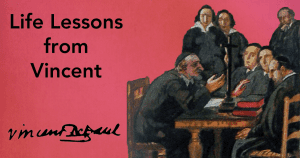In the world of institutional ministries such as hospitals and educational institutions, I often hear the maxim “No margin, no mission.” It express a tension faced by many ministries trying to navigate the realities of the business world, often described as “the real world.”
 In Mr. Vincent, J. Patrick Murphy writes of two experiences in Vincent’s life and the lessons we might learn from them:
In Mr. Vincent, J. Patrick Murphy writes of two experiences in Vincent’s life and the lessons we might learn from them:
A monk offered Vincent a huge property, Saint Lazare, outside Paris city limits. It was 74 acres and took an hour and a half to walk around the perimeter.Vincent refused it because, he said, it was too big, too expensive and would change the Congregation. He was right. The monk wanted to dump the property.
Lesson: The first law of economics: there is no free lunch. Be careful of Trojan horses and free lunches. Jim Collins encourages us to have BHAGs – Big Hairy Audacious Goals. Neither the monk nor Vincent saw the opportunity at first.
[Jim Collins is the author of Built to Last: Successful Habits of Visionary Companies]
Murphy continues,
Only one year later Vincent accepted Saint Lazare and moved in. It was full of mentally ill patients, lepers, errant sons of nobility, priests in trouble and many seriously poor. He was now running a 600+ bed hotel and it flourished from the very beginning.
Lesson: Sometimes it takes a while for a good plan to come together. (“God did it.”) Vincent found his Big Hairy Audacious Goal with the help of God.
Father Tom McKenna offers further details that help us appreciate the context of these insights. He writes in Vincent de Paul: A Saint Who Got His Worlds Together (PDF):
We move to the issue of Vincent’s familiarity with the world of business. A saint to be sure, it is clear that his sanctity came to blossom in a world of political hard knocks, financial and legal risk taking, and sometimes fierce corporate pressures.
His heavy involvement in the institutional world evolved because it was necessary to finance all the initiatives he undertook. Hospitals, shelters, seminaries, half-way houses, preaching teams, orphanages, soup kitchens, war relief campaigns – they all needed sound and long-term backing. This is not to say that Vincent’s primary aim was to build a financial empire. His eye was on the purpose of his foundations to assist the downtrodden. But, deeply involved in commerce he was. The amount of detailed effort he gave daily to overseeing his organizations, and in particular their funding, reveals an individual who knew firsthand the struggles of staying solvent in a volatile financial world.
In his time – as is most likely the case in most every other – money to support charitable organizations was scarce. To float his enterprises he had to take advantage of almost every income-producing system there was.
Vincent’s usual method was to secure some kind of endowment, manage it well, and build it up over time. He worked hard at convincing benefactors to donate profits from such diverse holdings as farms, mills, public transportation systems, and taxes on dry goods, wine, and salt. Capitalizing on the success of his early ventures, he persuaded a still wider circle of the wealthy to hand over to him amounts of cash and stocks as well as title to the income produced by various parishes, hospitals, and abbeys. So many of the thousands of letters he wrote are devoted to tracking these streams of revenue and keeping the channels open for increasing their yield.
Vincent’s preferred method of building up his capital was real estate. A giveaway line from one of his letters betrays this bent, probably a holdover from his deeply ingrained farm wisdom: wealth was in the land. “In order to preserve the institutions, the revenue must be in land. If not, fifty years from now, the endowment will be cut by half. The cost of things doubles every fifty years, at least.” It perhaps gives him more of a business credential to find out that his hunch about property values versus stocks was wrong. In the five decades after his death, real estate lost considerably against the market!
It is especially in his land dealings that we uncover the business side of Vincent. For him, it was never enough to be given property; its value must be made to increase. A recent study of seventeenth-century French business archives reveals a man with a method.
Reading the further details in the full article demonstrates that Vincent knew and understood the world of business.
He also knew that holiness is internally compatible with dealings in the marketplace. And that is the matter of the second part of the article.
For now, we can ask what are opportunities hidden in some challenge…and how can we navigate business realities if we take our time?





0 Comments